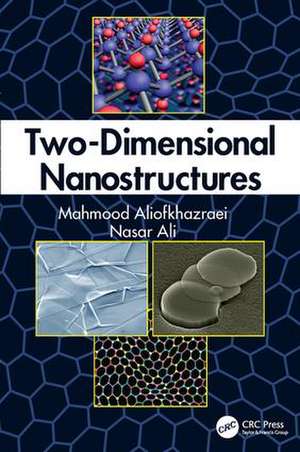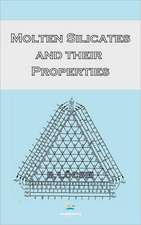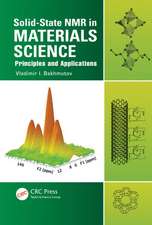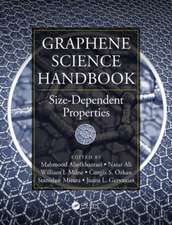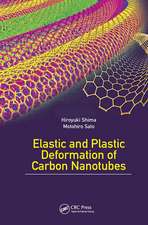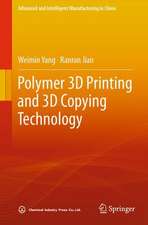Two-Dimensional Nanostructures
Autor Mahmood Aliofkhazraei, Nasar Alien Limba Engleză Paperback – 29 mar 2017
The authors begin with discussions on the properties, size effect, applications, classification groups, and growth of nanostructures. They then describe various characterization and fabrication methods, such as spectrometry, low-energy electron diffraction, physical and chemical vapor deposition, and molecular beam epitaxy. The remainder of the text focuses on mechanical, chemical, and physical properties and fabrication methods, including a new mechanical method for fabricating graphene layers and a model for relating the features and structures of nanostructured thin films.
With companies already demonstrating the capabilities of graphene in a flexible touch-screen and a 150 GHz transistor, nanostructures are on their way to replacing silicon as the materials of choice in electronics and other areas. This book aids you in understanding the current chemical, mechanical, and physical processes for producing these "miracle materials."
| Toate formatele și edițiile | Preț | Express |
|---|---|---|
| Paperback (1) | 752.04 lei 6-8 săpt. | |
| CRC Press – 29 mar 2017 | 752.04 lei 6-8 săpt. | |
| Hardback (1) | 1929.95 lei 6-8 săpt. | |
| CRC Press – 2 mai 2012 | 1929.95 lei 6-8 săpt. |
Preț: 752.04 lei
Preț vechi: 917.12 lei
-18% Nou
Puncte Express: 1128
Preț estimativ în valută:
143.95€ • 156.41$ • 120.99£
143.95€ • 156.41$ • 120.99£
Carte tipărită la comandă
Livrare economică 21 aprilie-05 mai
Preluare comenzi: 021 569.72.76
Specificații
ISBN-13: 9781138075955
ISBN-10: 1138075957
Pagini: 322
Ilustrații: 258 equations; 24 Tables, black and white; 134 Illustrations, black and white
Dimensiuni: 156 x 234 x 17 mm
Greutate: 1.93 kg
Ediția:1
Editura: CRC Press
Colecția CRC Press
ISBN-10: 1138075957
Pagini: 322
Ilustrații: 258 equations; 24 Tables, black and white; 134 Illustrations, black and white
Dimensiuni: 156 x 234 x 17 mm
Greutate: 1.93 kg
Ediția:1
Editura: CRC Press
Colecția CRC Press
Cuprins
Synthesis, Processing and Application of Nanostructures. Classification of Two-Dimensional Nanostructures. Characterization and Fabrication Methods of Two-Dimensional Nanostructures. Mechanical Fabrication/Properties of Two-Dimensional Nanostructures. Chemical/Electrochemical Fabrication/Properties of Two-Dimensional Nanostructures. Physical and Other Fabrication/Properties of Two-Dimensional Nanostructures. Index.
Notă biografică
Mahmood Aliofkhazraei is a researcher in the corrosion and surface engineering group at the Tarbiat Modares University. Dr. Aliofkhazraei has received several honors, including the Khwarizmi award and the best young nanotechnologist award of Iran. He is a member of the National Association of Surface Sciences, Iranian Corrosion Association, and National Elite Foundation of Iran. His research focuses on nanotechnology and its use in surface and corrosion science.
Nasar Ali is the chairman of NANOSMAT and a director of CNC Coatings. Dr. Ali’s research interests include chemical vapor deposition processes, polymer-based nanocomposites, nanotechnology, and vacuum coating.
Nasar Ali is the chairman of NANOSMAT and a director of CNC Coatings. Dr. Ali’s research interests include chemical vapor deposition processes, polymer-based nanocomposites, nanotechnology, and vacuum coating.
Recenzii
This is a book that combines presentation of state-of-the-art scientific techniques employing a highly pedagogical approach that makes it suitable for use in advanced classes in Chemistry and Materials Science. The first chapter includes a brief, but essential, introduction to all aspects of nanomaterials, with emphasis on size-dependent properties, which also makes it suitable as an introductory text for nanoscience. The following chapters focus on the hot topic of two-dimensional nanomaterials; most aspects of synthesis, characterization, physical and chemical properties are discussed. This is an excellent source of information for the hottest research topic of our decade.
—Ioannis Remediakis, University of Crete, Greece
I like the approach followed by the book. First of all, key concepts in nanoscience are introduced from the very beginning, and then the main features that characterize the 2D nanomaterials are presented and thoroughly developed. … The way that the book contents are organized makes it really appealing to anyone working in the field of nanoscience and nanotechnology.
—Eva Pellicer, Universitat Autònoma de Barcelona, Spain
Given the increase in research and technological applications of nanolayered 2-D materials recently, this book is being published at the right time. Although the focus is on graphene, the coverage is broader and covers other 2-D nanosystems as well. … The presentation of concepts of synthesis and properties of nanostructures is at a simple level, easy to understand and appropriate for graduate students.
—Amit Misra, Los Alamos National Laboratory, New Mexico, USA
… a highly arranged and well-organized approach to study the low-dimensional structures … This book can be recommended to both students and researchers working in the field of nanotechnologies. The relatively large number of figures and suitable physical explanation of low-dimensional effects make understanding the subject easier.
—Alex Axelevitch, Holon Institute of Technology, Israel
—Ioannis Remediakis, University of Crete, Greece
I like the approach followed by the book. First of all, key concepts in nanoscience are introduced from the very beginning, and then the main features that characterize the 2D nanomaterials are presented and thoroughly developed. … The way that the book contents are organized makes it really appealing to anyone working in the field of nanoscience and nanotechnology.
—Eva Pellicer, Universitat Autònoma de Barcelona, Spain
Given the increase in research and technological applications of nanolayered 2-D materials recently, this book is being published at the right time. Although the focus is on graphene, the coverage is broader and covers other 2-D nanosystems as well. … The presentation of concepts of synthesis and properties of nanostructures is at a simple level, easy to understand and appropriate for graduate students.
—Amit Misra, Los Alamos National Laboratory, New Mexico, USA
… a highly arranged and well-organized approach to study the low-dimensional structures … This book can be recommended to both students and researchers working in the field of nanotechnologies. The relatively large number of figures and suitable physical explanation of low-dimensional effects make understanding the subject easier.
—Alex Axelevitch, Holon Institute of Technology, Israel
Descriere
This book aids you in understanding the current processes for producing two-dimensional nanostructures. The authors discuss the "size effect" in two-dimensional nanostructures and cover applications of these materials. They focus on mechanical, chemical, and physical properties and fabrication methods, including a new mechanical method for fabricating graphene layers, a thermodynamic method of codeposition, and a model for relating the features and structures of nanostructured thin films. Many figures illustrate the fabrication methods.
